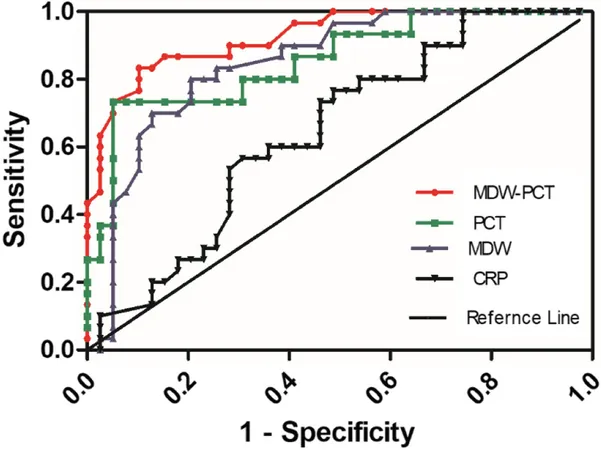
Unlocking Early Detection: The Power of Combined Monocyte Distribution Width and Procalcitonin in Diagnosing Neonatal Sepsis
2025-01-15
Author: Sarah
Introduction: A Lifesaving Approach to Neonatal Care
Neonatal sepsis is a critical condition affecting newborns, characterized by a high mortality rate and significant long-term complications. Due to the immaturity of their immune systems, symptoms in neonates can often be nonspecific, leading to delays in diagnosis. Recent research has highlighted the potential of combining Monocyte Distribution Width (MDW) and Procalcitonin (PCT) as a promising diagnostic tool that can improve both the speed and accuracy of sepsis detection.
Study Overview: Groundbreaking Research from Donghai Hospital
In a retrospective study conducted at Donghai Hospital from January 2022 to December 2023, researchers analyzed data from 39 cases of confirmed neonatal sepsis and 30 cases of non-infectious systemic inflammatory response syndrome (SIRS). They aimed to compare the diagnostic values of MDW, PCT, and C-reactive protein (CRP) levels to assess their roles in effectively diagnosing neonatal sepsis and predicting outcomes.
Key Findings: Significance of MDW and PCT in Diagnosis
The study found that MDW, PCT, and CRP levels were markedly higher in infants diagnosed with sepsis. Particularly striking were the results showing MDW's correlation with other inflammatory markers, with non-survivors exhibiting significantly higher MDW levels. This study established that MDW is an independent predictor of 28-day mortality, suggesting its critical role in early diagnosis. The research revealed optimal cut-off values for MDW, PCT, and CRP of 21.3, 1.23 ng/ml, and 32.8 mg/L, respectively. When MDW was combined with PCT, the diagnostic accuracy was further enhanced, yielding impressive sensitivity of 88.2% and specificity of 88.7%.
The Importance of Rapid Diagnostics: A Growing Need
Traditional blood culture methods, while widely used, can require up to 48 hours to deliver results, delaying critical treatment. Novel inflammatory markers, particularly MDW, have emerged as rapid and reliable options. Changes in monocyte volume in response to infection indicate that MDW can be particularly effective for early detection of neonatal sepsis.
Implications for Clinical Practice: A Clear Path Forward
The implications of these findings are significant for healthcare providers. As the study demonstrates, MDW can serve not only as a diagnostic tool but also as a valuable prognostic indicator. By integrating MDW and PCT testing into routine clinical practice, healthcare professionals could enhance their ability to detect and respond to neonatal sepsis swiftly, potentially saving countless vulnerable lives.
Future Directions: Expanding the Research Horizon
While this study provides a promising step forward, it also highlights the need for further research to confirm these findings across larger, multi-center cohorts. The focus should remain on establishing MDW's effectiveness in diverse clinical settings to solidify its role in detecting neonatal sepsis.
Conclusion: A Beacon of Hope for Neonatal Care
As neonatal sepsis continues to pose a significant health challenge, the combination of MDW and PCT presents a groundbreaking method for achieving early diagnosis and optimal management. The potential of these hematologic markers may revolutionize neonatal care practices, ultimately leading to better survival rates and improved outcomes for affected infants.
With the continued exploration of such innovative approaches, the future of neonatal healthcare looks increasingly bright. Stay tuned as we unravel more developments in the fight against neonatal sepsis, transforming challenges into opportunities for better health outcomes!


 Brasil (PT)
Brasil (PT)
 Canada (EN)
Canada (EN)
 Chile (ES)
Chile (ES)
 Česko (CS)
Česko (CS)
 대한민국 (KO)
대한민국 (KO)
 España (ES)
España (ES)
 France (FR)
France (FR)
 Hong Kong (EN)
Hong Kong (EN)
 Italia (IT)
Italia (IT)
 日本 (JA)
日本 (JA)
 Magyarország (HU)
Magyarország (HU)
 Norge (NO)
Norge (NO)
 Polska (PL)
Polska (PL)
 Schweiz (DE)
Schweiz (DE)
 Singapore (EN)
Singapore (EN)
 Sverige (SV)
Sverige (SV)
 Suomi (FI)
Suomi (FI)
 Türkiye (TR)
Türkiye (TR)
 الإمارات العربية المتحدة (AR)
الإمارات العربية المتحدة (AR)